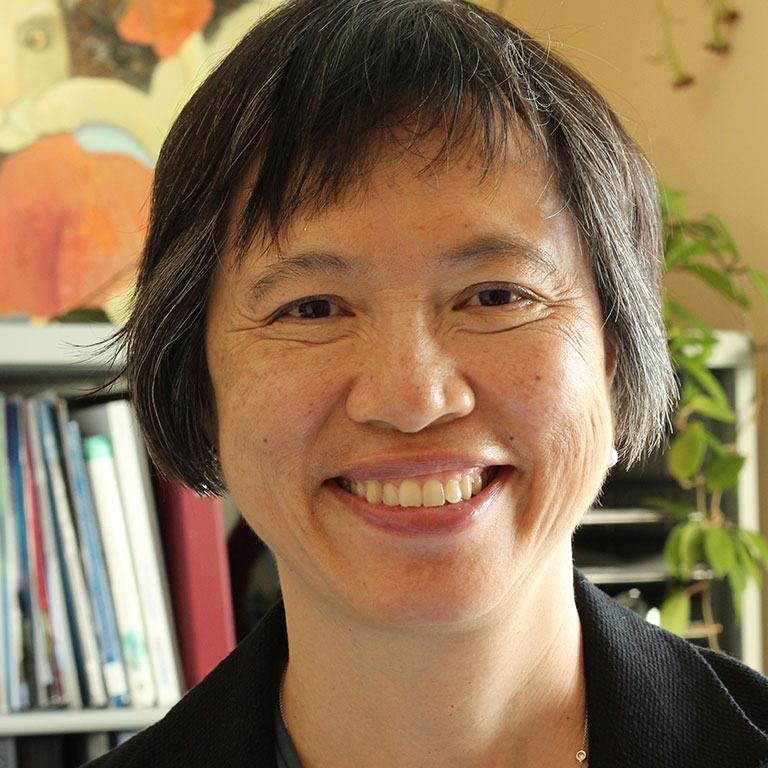1979 BS, Biology, University of California, CA
1986 Ph.D., Pharmacology, Yale University, New Haven, CT

Yvonne Lai
Scientist

Scientist
1979 BS, Biology, University of California, CA
1986 Ph.D., Pharmacology, Yale University, New Haven, CT
The central goal of my research is to identify disruptors of specific protein-protein interactions as novel drug discovery targets. Disruption of protein-protein interactions by small molecules was once considered to be an impossible goal for drug development. My team at ICOS discovered the first small molecule inhibitor of the nNOS-PSD95 protein-protein interaction and demonstrated that it decreases NMDA-induced hyperalgesia and mechanical allodynia. Since the nNOS-PSD95 signaling complex mediates many aspects of signaling of the excitatory neurotransmitter glutamate, disruption of the nNOS-PSD95 complex is expected to be beneficial for treating neuronal disorders involving aberrant glutamate receptor signaling. In collaboration with Dr. Andrea Hohmann we have shown that our novel nNOS-PSD95 inhibitors have efficacy in multiple pain models. Our collaboration with Dr. Anantha Shekhar at IUSM has shown that disruption of the nNOS-PSD95 interaction decreases fear conditioning in a preclinical model of posttraumatic stress disorder. The primary approaches we use are molecular biology, biochemistry, cell culture and preclinical models to examine the roles that different protein-protein interaction complexes played in excitatory neurotransmitter signaling.
Guindon J, Lai Y, Takacs SM, Bradshaw HB and AG Hohmann (2013). Alternations in endocannabinoid tone following chemotherapy-induced peripheral neuropathy: effects of endocannabinoid deactivation inhibitors targeting fatty-acid amide hydrolase and monoacylglycerol lipase in comparison to reference analgesics following cisplatin treatment. Pharmacol Res. 67(1),94-109.
Lai Y, Adhikarakunnathu S, Bhardwaj K, Ranjith-Kumar CT, Wen Y, Jordan JJ, Wu L, Dragnea B, Mateo LS, Kao CC. (2011). LL37 and cationic peptides enhance TLR3 signaling by viral double-stranded RNAs. PLoS One, 6(10), e26632.
Lai Y, Yi G, Chen A, Bhardwaj K, Tragesser BJ, Valverde RA, Zlotnick A, Mukhopadhyay S, Ranjith-Kumar CT, Kao CC. (2011). Viral double-strand RNA-binding proteins can enhance innate immune signaling by Toll-like receptor 3. PLoS One 6(10), e25837.
Ranjith-Kumar CT, Lai Y, Sarisky RT, Kao, CC. (2010). Green tea catechin, epigallocatechin gallate, suppresses signaling by the dsRNA innate immune receptor RIG-I. PLoS One, 5(9), e12878.
Florio SK, Loh C, Huang SM, Iwamaye AE, Kitto KF, Fowler KW, J.A. Treiberg, J.S. Hayflick, J.M. Walker, C.A. Fairbanks & Y. Lai. (2009). Disruption of nNOS-PSD95 protein-protein interaction inhibits acute thermal hyperalgesia and chronic mechanical allodynia in rodents. British Journal of Pharmacology, 158(2),494-506.
Kashishian A, Howard M, Loh C, Gallatin WM, Hoekstra MF, Lai Y. (1998). AKAP79 inhibits calcineurin through a site distinct from the immunophilin-binding region. Journal of Biological Chemistry, 273(42), 27412-27419.
Hill P, Lai Y, Hnilo J, Lin CC, Karla M, Bounds S, Herz J, Mitchell R. (1996). Cloning, expression, and comparison of the binding characteristics of the known human dopamine receptors. Advances in Neurology, 69, 41-52.
Mackie K, Lai Y, Westenbroek R, Mitchell R. (1995). Cannabinoids activate an inwardly rectifying potassium conductance and inhibit Q-type calcium currents in AtT20 cells transfected with rat brain cannabinoid receptor.Journal of Neuroscience, 15(10), 6552-6561.
Lai Y, Peterson BZ, Catterall WA. (1993). Selective dephosphorylation of the subunits of skeletal muscle calcium channels by purified phosphoprotein phosphatases. Journal of Neurochemistry, 61(4), 1333-1339.
Lai Y, Seagar MJ, Takahashi M, Catterall WA. (1990). Cyclic AMP-dependent phosphorylation of two size forms of alpha 1 subunits of L-type calcium channels in rat skeletal muscle cells. Journal of Biological Chemistry, 265(34), 20839-20848.
Lai Y, Nairn AC, Gorelick F, Greengard P. (1987). Ca2+/calmodulin-dependent protein kinase II: identification of autophosphorylation sites responsible for generation of Ca2+/calmodulin-independence. Proceedings Natlional Academy of Science U S A, 84(16), 5710-5714.
Lai Y, Nairn AC, Greengard P. (1986). Autophosphorylation reversibly regulates the Ca2+/calmodulin-dependence of Ca2+/calmodulin-dependent protein kinase II. Proceedings Natlional Academy of Science USA, 83(12), 4253-4257.
McGuinness TL, Lai Y, Greengard P. (1985). Ca2+/calmodulin-dependent protein kinase II. Isozymic forms from rat forebrain and cerebellum. Journal of Biological Chemistry, 260(3), 1696-1704.
McGuinness TL, Lai Y, Greengard P, Woodgett JR, Cohen P. (1983). A multifunctional calmodulin-dependent protein kinase. Similarities between skeletal muscle glycogen synthase kinase and a brain synapsin I kinase. FEBS Letter, 163(2), 329-334.
Lockerbie, R. O., M.L. Howard, W.M. Gallatin and Y. Lai (2000) Modulators of anchoring protein function, patent. US patent 6,107,104.